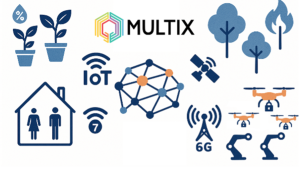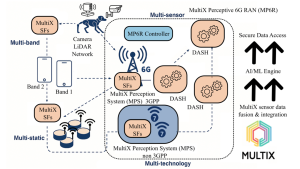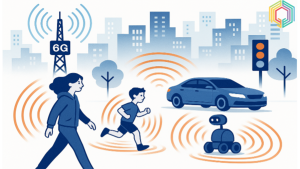A new approach is to combine communication and sensing for a smarter, faster, and safer environment to realize a new era of wireless networks.
Until recently, we used wireless networks to send data. Whether it was a phone call, video or browsing your favorite social network, the job was to communicate information from one point to another. It’s all about to change.
Currently defined as the next generation of wireless technology, 6G is expected to open a new chapter. It’s not just sending data. It also senses, interprets, and responds to the world around it. Like radars and cameras, these smart systems detect motion, understand the environment, and respond in real time, but just like radars and cameras, they are embedded in the network.
This exciting shift is being pioneered by a European research initiative called Multix (synthesizes the advancement of 6G radio access networks through multi-technology, multi-sensor fusion, multi-band, and multi-stage perception – see Figure 1). Multix is developing a new kind of network with support from the European Commission and academia and industry partners.

Why is sensing important?
Imagine a factory where networks not only connect robots, but track them, monitor air quality, and detect obstacles without extra sensors than the network itself. Or the city where your cell phone helps you look around your car. These are not distant dreams. They are real-world scenarios that Multix is already working on.
But making this possible is not a small task. Today’s networks are designed for communication rather than perception. Integrating sensing requires new technologies, smarter coordination, and intelligent ways to fuse data from many sources, from Wi-Fi signals to mobile networks, and even radar, light detection and range (LIDAR). This integration is the focus of Multix.
Smarter networks from scratch
At the heart of the Multix project are simple but powerful ideas. If wireless networks can also be sensed, they can be much more convenient. To achieve this
Multix is building a new type of system called the Multix Fusion Perceptive 6G-Radio Access Network (MP6R for short). This fusion allows the network to acquire new capabilities. The MP6R system is based on four main ideas:
Multi-sensor Fusion: Just as the brain combines inputs from visual, sound and touch to understand the world, Multix fuses data from multiple sensing technologies such as Wi-Fi, 5G, cameras, Lidar, and radar to understand the environment more richly and accurately. Each sensor type offers unique strength. Wi-Fi and 5G can detect movement and position through signal changes. The camera provides visual context and object recognition, while the radar and lidar provide accurate depth and range information. By integrating all these inputs in real time, Multix can interpret complex scenarios, adapt to changing conditions, and make smarter decisions. Multi-band operation: Different radio frequencies are excellent for a variety of tasks. Lower frequencies move further, while higher frequencies provide more detail. Multix uses a combination of sub-6 GHz (traditional frequencies used in Wi-Fi, 4G, and 5G) and millimeter waves that operate at higher frequencies. Millimeter waves have a shorter range, but they provide higher bandwidth and data rates, allowing for greater sensing resolution. Multix combines this information into unified sensing data, making the most of both worlds. Multi-stage Sensing: Instead of relying on a single fixed sensor, Multix connects multiple devices – spreads across different locations, all sense the environment. By sharing and comparing data, the system can triangulate locations, detect subtle movements, and track objects with high accuracy, even in areas with obstacles and signal interference. Multi-technology Integration: Multix treats all wireless technologies as part of a single sensing fabric. Signals, whether from different cellular network technologies (4G, 5G, 6G) or Wi-Fi, fuse them into one cohesive stream of information. This allows you to work on a variety of platforms and standards, and unlock reliable and intelligent sensing in any configuration.
These basic ideas enhance the bold new vision of wireless networks. In other words, it is a network that not only connects but also understands the world around you. To realize this vision, Multix focuses on two key elements: This is a real-world use case that demonstrates the building blocks that make up this sensory-enabled infrastructure and their potential. The next section will explain in detail these, starting with the core components that allow this transformation, and then explain how they are applied in environments such as advanced manufacturing.
Brain, eyes, multi-memory
Together, these features allow Multix to understand its environment and respond quickly, making the entire network more intelligent and adaptable.
To achieve sensing over wireless networks, Multix is built around three key components: Each person plays a unique role, just like the human body (see Figure 2).

Eye: Multix Perception System (MPS)
This is part of the network that does the actual sensing. MPS can be installed on various parts of the network. It can be installed on an antenna, a base station, or even a device you carry. Listen to wireless signals already transmitted and extract useful information such as movement, location, and activity within your environment.
Think of it as a distributed network of “eyes” that quietly observe what’s going on around them without the need for extra cameras or sensors.
Brain: MP6R Controller (MP6RC)
Once data is collected, someone needs to understand it. That’s the job of MP6RC. It acts as the central brain of the system, tuning all the different technologies (5G, Wi-Fi, etc.) to ensure everything works smoothly.
It also helps you decide how and where to process your data and adapt your network in real time. For example, shift resources or improve service quality in busy areas.
Memory: Data Access and Security Hub (Dash)
Dash is where sensing data is stored, processed and shared, but it is always a secure and controlled way. Make sure your sensitive information is protected, make it available to certified users and ready to use for smart decisions.
It also allows Multix to use advanced tools such as artificial intelligence, allowing you to combine different data sources to find patterns and predict them.
Digital twins to see, think and act
To demonstrate that Multix can be done, the team created a real-world example called a multi-layer digital twin for industrial manufacturing. The idea is simple. This is a virtual copy of the actual factory that continuously learns from the environment and retrieves information from various sensors, including the network itself.
In this setup, the digital twin uses data collected from the network via “Eyes” (MPS), “Brain” (MP6RC), and “Memory” (Dash) to understand what’s going on on the factory floor. You can even track the robot, detect when something is wrong, and suggest the best way to fix the problem before it happens.
Because it works in real time, the digital twin helps the network adapt instantly. For example, if a machine begins to move and requires a reliable connection, the network can respond and make sure the machine remains connected without delay. That’s a big deal in an environment where even small mistakes can stop the entire production line.
However, digital twins are not just machines. It also helps people and robots work together safely, efficiently and in new ways. By combining real data with smart algorithms, it supports better decision-making, saves energy and unlocks new possibilities for automation.
In short, this digital twin is a glimpse into the future of the smart industry, proving that networks can do much more than just connect us.
What’s next for the sensing network?
Multix is more than just a research project. This is a step towards a future in which wireless networks actively sense, interpret and support the world around them. This evolution is not just about smarter technology. It is about creating true concrete benefits for society.
By combining communication and sensing, Multis opens the road to safer roads. There, vehicles and infrastructure can respond more intelligently to the surroundings. This allows for smarter hospitals, and the network quietly monitors patients without intrusive sensors. In cities, they support cleaner and more sustainable living by helping systems respond instantly to changes in the environment. On factory floors, the industry becomes more efficient and adaptable, detecting problems before escalating, ensuring seamless automation. And in our daily lives, it lays the foundation for more inclusive digital services. There, people naturally interact with technology that understand the context and adapts in real time.
What really makes Multix powerful is its flexibility. It does not depend on a single standard or setup. Instead, we’ll put together a range of technologies, frequencies, and sensing methods that will adapt to different environments and needs. Whether improving public safety, supporting remote workers, or leading autonomous machines, the multi-z approach responds not only to technical challenges, but to human challenges (see Figure 3).

Of course, the journey is not over. The team is currently focusing on making this vision scalable, fast and safe. Meanwhile, it ensures that data privacy and trust remains at its core. But one thing is already clear. The future networks don’t just connect people and devices. They will play an active role in understanding their surroundings, anticipating their needs, and building a more intelligent, sustainable, and human-centric world. In Multix, that future is already in shape.
ACK Multix Project receives funding from Smart Networks and Service Joints Business (SNS JU) 101192521 under the European Union’s Horizon Europe Research and Innovation Program.
Business (SNS JU) 101192521 under the European Union’s Horizon Europe Research and Innovation Program.
This article will also be featured in the 22nd edition of Quarterly Publication.
Source link

